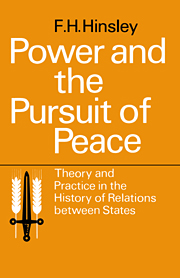Book contents
- Frontmatter
- Contents
- INTRODUCTION
- PART I A HISTORY OF INTERNATIONALIST THEORIES
- 1 To the End of the Seventeenth Century
- 2 Penn, Bellers and Saint-Pierre
- 3 Rousseau
- 4 Kant
- 5 Bentham and James Mill
- 6 The First Half of the Nineteenth Century
- 7 From the Crimean War to the League of Nations
- PART II A HISTORY OF THE MODERN STATES' SYSTEM TO 1900
- PART III INTERNATIONAL RELATIONS AND INTERNATIONAL ORGANIZATIONS IN THE TWENTIETH CENTURY
- References
- Index
1 - To the End of the Seventeenth Century
Published online by Cambridge University Press: 11 January 2010
- Frontmatter
- Contents
- INTRODUCTION
- PART I A HISTORY OF INTERNATIONALIST THEORIES
- 1 To the End of the Seventeenth Century
- 2 Penn, Bellers and Saint-Pierre
- 3 Rousseau
- 4 Kant
- 5 Bentham and James Mill
- 6 The First Half of the Nineteenth Century
- 7 From the Crimean War to the League of Nations
- PART II A HISTORY OF THE MODERN STATES' SYSTEM TO 1900
- PART III INTERNATIONAL RELATIONS AND INTERNATIONAL ORGANIZATIONS IN THE TWENTIETH CENTURY
- References
- Index
Summary
People often study history less for what they might learn than for what they want to prove. This is one reason why so much is known about internationalist theories since the end of the Middle Ages. Vast efforts have been made, innumerable books have flowed, from the wish to cite Dubois or Dante, Crucé or Sully, as forerunners of the League of Nations or United Europe or the United Nations experiment―and from the even more curious supposition that it was necessary to study these early writings for guidance in creating, improving or saving these twentieth-century projects.
There has in truth been some justification for this faith in the value of past experience. In modern history war-prevention theories have increasingly been based on the argument that it is essential to establish some organisation for regulating the relations of sovereign states; the first plans to use this argument naturally made their appearance in the early days of the modern states' system. For even if it was an immense intellectual achievement to conceive of the wheel, as is often asserted but far from being proved, the same cannot be said of the notion of an organisation between states once separate states existed. But even if these early plans had had any relevance to practicability when they were formulated, which was rarely so, they would still have no relevance to modern situations.
- Type
- Chapter
- Information
- Power and the Pursuit of Peace: Theory and Practice in the History of Relations Between States , pp. 13 - 32Publisher: Cambridge University PressPrint publication year: 1962



